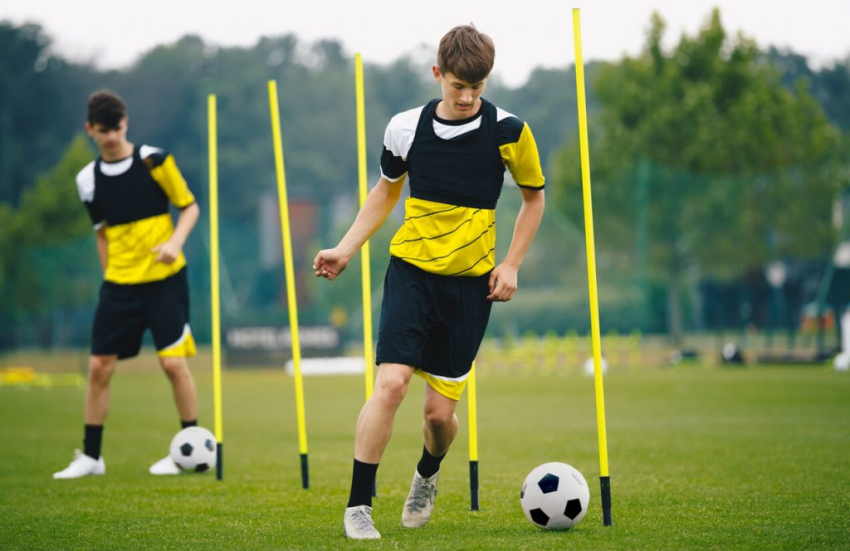Football training has become an essential cornerstone in the development of athletes, blending traditional practices with cutting-edge advancements in the science of football. As the sport continues to evolve, coaches and players are increasingly adopting innovative football training techniques that leverage performance optimization in football. With the integration of technology, including virtual reality in sports, training programs are becoming more immersive and effective than ever. This blending of empirical research with practical strategies is shaping the way players prepare, particularly during the NFL offseason training period. By understanding the critical elements of football training, athletes can refine their skills and enhance their performance on the field.
The realm of training for football athletes encompasses a variety of methodologies aimed at enhancing their overall capabilities. Through a deep dive into contemporary training strategies, athletes now engage in practices that not only boost their physical prowess but also their tactical acumen. The infusion of advanced techniques—ranging from simulation technologies to the understanding of sport science—plays a pivotal role in maximizing player performance. With a focus on ensuring players are sufficiently prepared for the rigors of competition, the significance of structured training regimens cannot be overstated. As we explore these modern techniques, we will uncover how they contribute to the overarching goal of achieving excellence in football.
The Impact of Football Training Techniques on Player Performance
Modern football training techniques are crucial to enhancing player performance on the field. These techniques combine elements of physical conditioning, tactical awareness, and technical skills, all aimed at refining the player’s abilities to compete at the highest level. For instance, methodologies such as high-intensity interval training (HIIT) and sport-specific drills have become mainstream due to their effectiveness in increasing endurance and agility, vital attributes for any professional player. Coaches are now able to tailor these training modules to meet the specific needs of each player, fostering a more personalized and effective training regimen.
Additionally, the integration of performance analytics into football training is revolutionizing how coaches approach player development. By utilizing data collected during training sessions and matches, coaches can make informed decisions about adjustments needed in their training programs. Data analytics not only helps in identifying players’ strengths and weaknesses but also in predicting potential injuries, thus enabling proactive measures. As such, the science of football training techniques goes beyond just physical training; it encapsulates a comprehensive view of player performance optimization.
Harnessing Technology: Virtual Reality in Football Training
Virtual reality (VR) has emerged as a groundbreaking tool in football training, providing players with an immersive environment to enhance their skills. Through VR simulations, players can experience realistic match scenarios without the physical strain of actual practice. This technology allows athletes to develop their decision-making abilities and technical skills in a controlled setting, replicating the fast-paced nature of a live game. As players engage with virtual opponents and environments, they are also improving their tactical awareness and cognitive response times, essential components for any successful footballer.
Moreover, the application of VR in football training is not limited to skill enhancement; it also plays a pivotal role in mental conditioning. By familiarizing players with various game situations through visualization techniques, they can better manage stress and maintain focus during critical moments of actual matches. As the sport evolves, integrating virtual reality into training regimens aligns perfectly with the ongoing advancements in performance optimization in football. This highlights the invaluable role technology plays in shaping modern athletes, ensuring they are well-prepared for the competitive landscape.
Frequently Asked Questions
What are the benefits of integrating science into football training techniques?
Integrating science into football training techniques enhances player performance by tailoring training regimens based on empirical research. This approach leads to improved physical and mental conditioning, reduces injury risks, and optimizes overall efficiency. Techniques informed by sports science, such as tailored conditioning programs and recovery strategies, allow athletes to maximize their potential on the field.
How does virtual reality in sports improve football training?
Virtual reality in sports revolutionizes football training by creating immersive scenarios that closely mimic real match conditions. This technology enhances players’ decision-making skills and game awareness, allowing them to practice under pressure and adapt to various tactical situations. By simulating complex game environments, VR enables players to refine their skills, anticipate opponents’ moves, and react effectively during actual gameplay.
| Key Aspect | Description |
|---|---|
| Modern Football Training | Integrates sports science and technology to enhance training effectiveness. |
| Sports Science Role | Educates athletes on training principles to improve performance and recovery. |
| Simulation Technologies | Mimics real game scenarios to develop skills in a controlled environment. |
| Virtual and Augmented Reality | Enhances player decision-making through immersive training experiences. |
| Comprehensive Methodologies | Targeted training methods for physical, technical, tactical, and mental development. |
| Continuous Learning | Emphasizes the need for coaches and players to adapt to new scientific findings. |
Summary
Football training is inherently rooted in science, drawing from modern advancements to optimize athletes’ performance. The evolution of training techniques has paved the way for professional footballers to develop their skills more efficiently than ever. By leveraging the insights provided by sports science, athletes are not only minimizing the risk of injuries but are also maximizing their potential on the field. As a result, training regimens that include cutting-edge simulation technologies, virtual reality, and comprehensive methodologies are essential for every aspiring footballer. This deliberate integration of science into practice ensures that players are well-prepared for the competitive nature of football, marking a significant shift toward a more strategic and focused approach to training.
